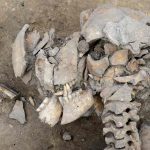Scientists decipher purpose of mysterious astronomy tool made by ancient Greeks0
- Ancient Archeology, From Around the Web
- June 13, 2016
Inscriptions on Antikythera Mechanism suggests it was mechanical computer used to track sun, moon

Inscriptions on Antikythera Mechanism suggests it was mechanical computer used to track sun, moon

Neolithic group found in silo appeared to have suffered violent deaths, with multiple injuries to legs, hands and skulls

A famous fossil trove in Argentina recently gave up a new treasure: the first fossil footprints ever reported of the saber-toothed cat Smilodon.

The well dates back 1800 years but the prophecy at the sanctuary was evidently much older, archaeologist says.

Massive fortifications and sunken ship-sheds thousands of years old were the base from which the Greek naval juggernaut overcame the Persians.

Something as delicate and intricate as nanotechnology couldn’t have been developed without first discovering the structure of atoms and inventing the microscope. But these are all recent advancements, leading us to wonder who in the seven skies built these microscopic ooparts some 300,000 years ago?

New technology can help archaeologists uncover new finds at old sites such as the pyramids at Giza, but it also can shift their perspective to look across civilizations.

The hobbit, shown in a reconstruction, may have had a long history on the Indonesian island of Flores.

For most of the last ice age, enormous glaciers covered western Canada. And yet people still managed to cross deep into the Americas from their settlements in western Alaska. How did they do it?

Stonehenge began life as an impressive Welsh tomb which was dismantled and shipped to Wiltshire, archaeologists now suspect.



